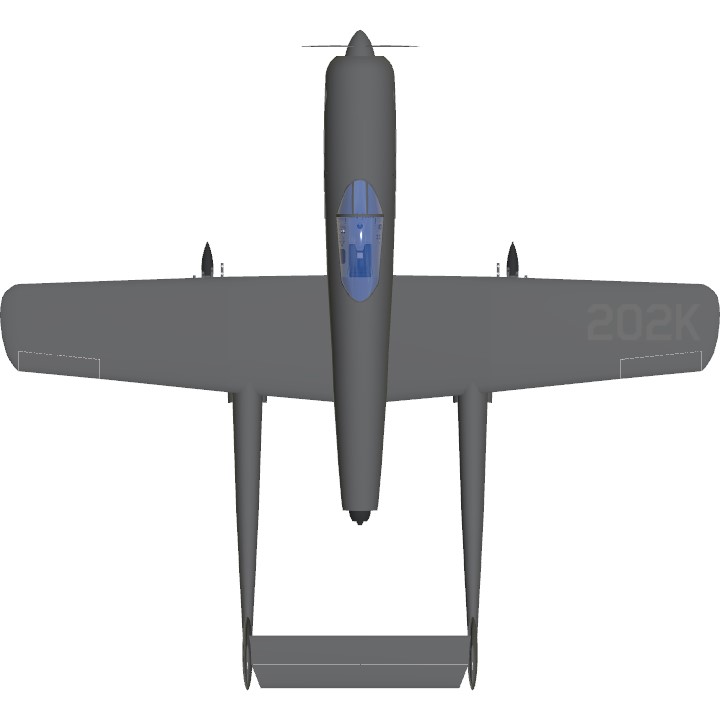A little disclaimer: The plane has more drag than it should, and since I don't have access to my PC I can’t edit the XML. If you want the plane to perform as intended, remove the drag from both rocket pylons
History
In a time before pure-jet aircraft could reign the sky, the solution to the mediocre performance of the jet engine at slower speeds was to strap a more conventional piston engine to the same airframe, and thus, the mixed-propulsion aircraft were born.
The Curtiss F16C was created for carrier operations in 1942, and by 1943 a prototype was ready. After rigorous testing, it was approved, and production began in 1944. The use of a twin-boom layout was unusual, but allowed for a bigger jet engine to be installed in the back, thus making it the fastest US fighter at the time. However, it wasn’t really liked by the mechanics because of it’s complexity to maintain and operate. Still, it was a very effective fighter and ground attacker, being used mainly in anti-ship missions due to it’s ability to install Big Berthas, it was able to outrun most enemies it encountered and thus was well liked by it’s crew.
By the end of the war in 1946, the F16C was already showing it’s age, and was quickly replaced by more advanced pure-jet aircraft. That wasn’t the end of it’s career, however, as it saw service as a ground attacker until the end of the Korean war.
This aircraft in specific is the “8 Ball”, being an improved version of the F16C with a redesigned cowling, allowing for greater power, and replacing the 20mm cannons it had for the more reliable AN/M2 Browning. The pilot of this aircraft is Jesse L. Browne, one of the first African-American pilots of the US Navy. (You should look him up, he has a really interesting story)
Performance
(Tested only with full payload)
Top Speed(TAS): 800 km/h at 6,000 m, 770 Km/h at sea level
Takeoff Speed(IAS): 200 km/h
Stall Speed(IAS): 210 km/h
Manufacturer: Curtiss Aeroplane and Motor Company
Produced: 1944-1946
Numbers Built: 2,469
Powerplant: 1 18 cylinder radial engine producing 2,250 hp, 1 turbojet producing 4,500 lbf
Armament: 8 AN/M2 50. machine guns, 2 Big Bertha anti-ship rockets (fictional Tiny Tims because I can’t be bothered to make them detailed)
Features
-VR compatible
-Semi-detailed damage model
-Ejection seat
-Realistic handling
-Custom landing gear
-Delayed throttle response
-Detailed cockpit (kinda)
Controls
AG-1: Bail out
AG-2: Tail hook
AG-3: Fold wings
AG-8: Turn off jet engine
Some tips and warnings
-Optimized for high physics
-Don’t hit your prop when landing!
-The rockets have a pretty big drop off, be careful aiming them!
-You’re not a dogfighter, use your speed at your advantage
-Have fun!
Specifications
Spotlights
- This craft is curated
- LonelyAustrianUhlan 2.0 years ago
- Rondine 2.0 years ago
- GreatWizard 2.0 years ago
- YarisSedan 1.9 years ago
- Dragoranos 1.9 years ago
General Characteristics
- Predecessor 1946 Specifications Challenge! [CLOSED]
- Created On iOS
- Wingspan 39.2ft (12.0m)
- Length 36.0ft (11.0m)
- Height 10.1ft (3.1m)
- Empty Weight 10,913lbs (4,950kg)
- Loaded Weight 13,447lbs (6,099kg)
Performance
- Power/Weight Ratio 1.504
- Horse Power/Weight Ratio 0.167
- Wing Loading 39.1lbs/ft2 (190.7kg/m2)
- Wing Area 344.3ft2 (32.0m2)
- Drag Points 2036
Parts
- Number of Parts 363
- Control Surfaces 2
- Performance Cost 1,817







@LieutenantSOT Thank you so much for giving me first place!
I’ll be sure to fix that next time, too
Oh yeah! The one thing of criticism I had for this beauty is that I feel like the ailerons were a tad too skinny, but other than that it's amazing!!!
@LieutenantSOT It’s good to hear that!
I promise I'll try her out soon, but both requirements-wise and realism-wise, I think this is the best submission and the most realistic. Great job!!
Handles like a dream!
@MemrWii 💀
AiM 9 approaching very fast: :3
Dude... you have hit all of my sweet spots for design choices. I will grade it in a little bit, but hey!
.
Approved